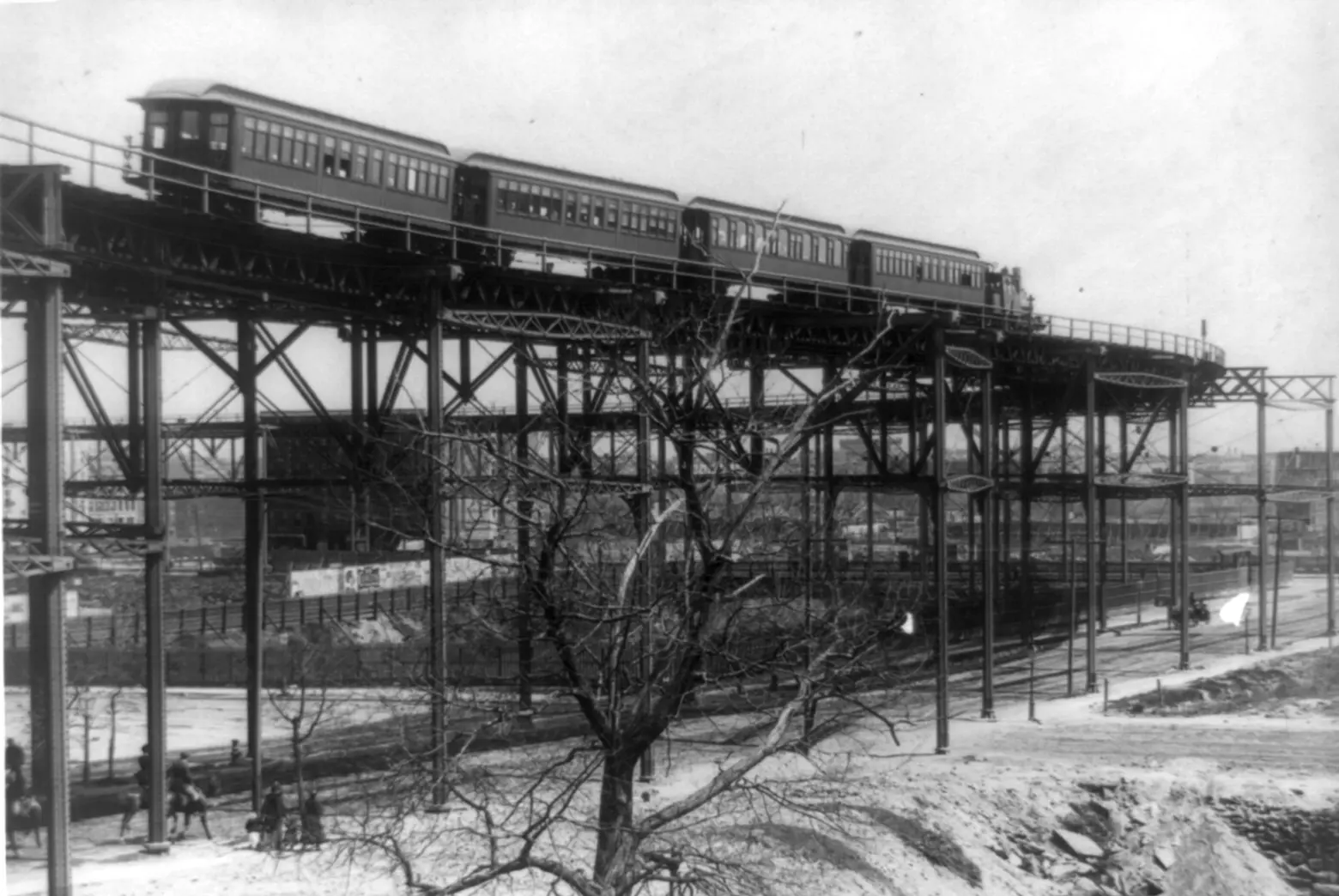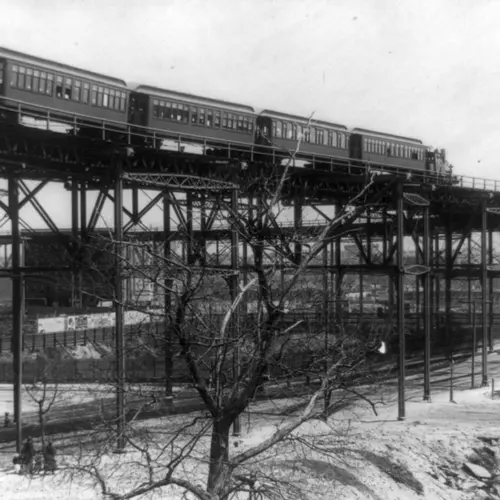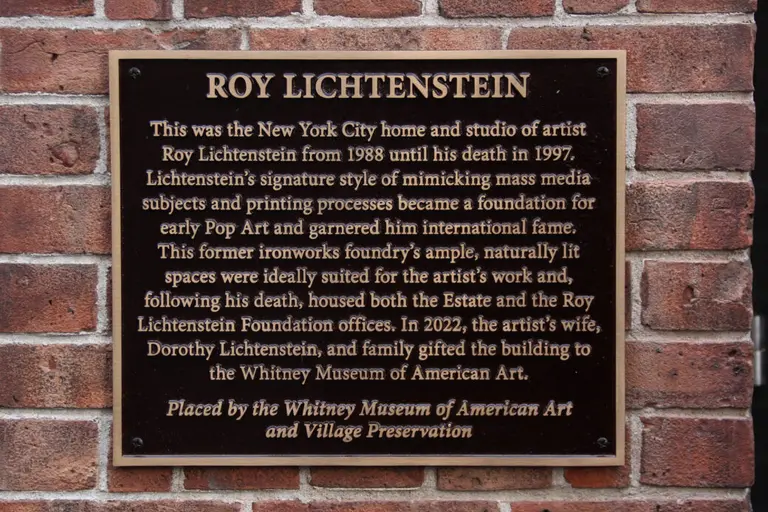NYC’s first elevated train and the world’s first streetcar began in Greenwich Village

The Ninth Avenue El near 14th Street c. 1914. Via Bain Collection, Library of Congress.
Greenwich Village is known as the birthplace of many things – the modern gay rights movement, Off-Broadway theater, the New York School of artists and poets, the “new urbanism” pioneered by Jane Jacobs, among many other trailblazing firsts. Less closely associated with the Village, however, are radical and transformative innovations in transportation technology. But while little known, the Village was in fact home to the first elevated rail line, and the first streetcar.
The Ninth Avenue Elevated Railway, or El, began operation in 1868, with a charter to run from Battery Place to 30th Street. London had an earlier aboveground railway, the London and Greenwich Railway, that ran on a series of brick viaducts, whereas the Ninth Avenue El ran on just a steel track and supports. In fact, the initial version was more or less an early prototype for what we would today call a monorail – it ran in a loop on a single track above a single row of columns. Pulled along by a cable, the engineering marvel became known as “the One-Legged Railroad,” and allowed New York City (then just the island of Manhattan) to expand rapidly northward during those booming years of the industrial revolution and mass immigration which followed the Civil War. It also allowed quicker transit above the increasingly congested Lower Manhattan streets, filled with horses, carts, streetcars, and people.

In Greenwich Village, the Ninth Avenue Elevated ran along Greenwich Street, now considered a quiet picturesque thoroughfare bisecting the West Village, but in the late 19th century, it was a rough and tumble amalgam of residential, industrial, and maritime life.

 Photos of 128 Charles Street courtesy of GVSHP
Photos of 128 Charles Street courtesy of GVSHP
While the El is long gone, you can still see evidence of the line at 128 Charles Street, a tenement built in 1881 at the corner of Greenwich Street. Between the third and fourth floors is a stone marker with “Charles Street” and “Greenwich Street” carved into it abutting the intersection. The sign is difficult to see and read at street level, but for the passenger on the Ninth Avenue El in the late 19th or early 20th century, it was a welcome indicator of the train’s location and progress.
 “Suicide Curve” in 1896, via Wiki Commons
“Suicide Curve” in 1896, via Wiki Commons
Just north of Charles Street, the El turned from Greenwich Street onto Ninth Avenue at Gansevoort Street, through Gansevoort Plaza in the heart of the Meatpacking District. This was one of the many curves the route of the Ninth Avenue El was known for as it wound its way uptown. At 110th Street, it hit what came to be known as “Suicide Curve,” where it took a particularly sharp but scenic turn to navigate around Morningside Park.
 But the most notorious bend in the line was at 53rd Street, where it intersected with the Sixth Avenue El. There on September 11, 1905, human error allowing trains from the two lines onto the track at the same time led to a massive derailment, killing 13 and injuring f49, including a policeman standing below. The accident was the deadliest in New York City transit history.
But the most notorious bend in the line was at 53rd Street, where it intersected with the Sixth Avenue El. There on September 11, 1905, human error allowing trains from the two lines onto the track at the same time led to a massive derailment, killing 13 and injuring f49, including a policeman standing below. The accident was the deadliest in New York City transit history.
 By the mid-20th century, City Hall was seeking to take over privately-run transit systems across the city, and eliminate dark and noisy elevated rail lines, at least in Manhattan. In the early 1930s, the IND line was built along 8th Avenue, shadowing the Ninth Avenue El with its more modern, quick, and efficient underground service. As planned, the new “Independent” train line put the Ninth Avenue El out of business, and most of the line was dismantled in 1940, with the final section extending into the Bronx coming down in 1958.
By the mid-20th century, City Hall was seeking to take over privately-run transit systems across the city, and eliminate dark and noisy elevated rail lines, at least in Manhattan. In the early 1930s, the IND line was built along 8th Avenue, shadowing the Ninth Avenue El with its more modern, quick, and efficient underground service. As planned, the new “Independent” train line put the Ninth Avenue El out of business, and most of the line was dismantled in 1940, with the final section extending into the Bronx coming down in 1958.
 1917 view of a New York horsecar on the left and an electric streetcar on the right on Broadway near 17th Street. Via Wiki Commons.
1917 view of a New York horsecar on the left and an electric streetcar on the right on Broadway near 17th Street. Via Wiki Commons.
Not long after the final leg of the Ninth Avenue El came down, New York City’s last streetcar or trolley also ran in 1958. This once ubiquitous form of mass transportation from which the Los Angeles Dodgers (originally the Brooklyn Trolley Dodgers) derive their name crisscrossed the five boroughs in a tangled web of routes. But the very first of these lines, not only in New York but the world, ran along the Village’s eastern flank beginning in 1832.
 Horse-drawn streetcars began operating decades earlier. But a unique innovation by the New York and Harlem and Railroad Company made such travel infinitely smoother and quicker. The company ushered in the modern streetcar age by for the first time embedding metal tracks in the roadway to carry the cars, initially pulled by horses but eventually by steam engines, cables, and electric current. That first line ran along the Bowery and Fourth Avenue, from Prince Street to Union Square, but with ambitions (later realized) of eventually reaching suburban Harlem.
Horse-drawn streetcars began operating decades earlier. But a unique innovation by the New York and Harlem and Railroad Company made such travel infinitely smoother and quicker. The company ushered in the modern streetcar age by for the first time embedding metal tracks in the roadway to carry the cars, initially pulled by horses but eventually by steam engines, cables, and electric current. That first line ran along the Bowery and Fourth Avenue, from Prince Street to Union Square, but with ambitions (later realized) of eventually reaching suburban Harlem.
 Postcard showing Cooper Square with both elevated trains and streetcars c. 1917. Via GVSHP Archives.
Postcard showing Cooper Square with both elevated trains and streetcars c. 1917. Via GVSHP Archives.
Around the time of the opening of this first modern streetcar line, you see some of New York’s grandest houses being built on neighboring streets such as St. Marks Place, Lafayette Place (now Street), Bond Street, and Second Avenue.
 That first streetcar to run along this new line was called the John Mason, named for the President of Chemical Bank and one of the wealthiest New Yorkers, who was also a co-founder of the railroad company. Believe it or not, this humble but groundbreaking transportation line eventually extended all the way to Westchester and is the direct forefather of today’s Metro-North Railway system, which carries millions of passengers each year from Grand Central north to Harlem, the Bronx, Connecticut, and Upstate New York.
That first streetcar to run along this new line was called the John Mason, named for the President of Chemical Bank and one of the wealthiest New Yorkers, who was also a co-founder of the railroad company. Believe it or not, this humble but groundbreaking transportation line eventually extended all the way to Westchester and is the direct forefather of today’s Metro-North Railway system, which carries millions of passengers each year from Grand Central north to Harlem, the Bronx, Connecticut, and Upstate New York.

Like the Ninth Avenue Elevated, the streetcar line faced enormous pressures from new forms of transportation and competing businesses intent upon seeing its undoing. After the company went into receivership and the line changed hands several times, in 1934 the New York Railways Corporation finally removed the streetcar from service, replacing it with a bus line. Today’s M1 bus line approximates the route of the original New York and Harlem streetcar line.
+++
This post comes from the Greenwich Village Society for Historic Preservation. Since 1980, GVSHP has been the community’s leading advocate for preserving the cultural and architectural heritage of Greenwich Village, the East Village, and Noho, working to prevent inappropriate development, expand landmark protection, and create programming for adults and children that promotes these neighborhoods’ unique historic features. Read more history pieces on their blog Off the Grid.
RELATED:
- World’s first streetcar began operation in lower Manhattan on November 14, 1832
- There’s a trolley car graveyard buried without a trace in Canarsie, Brooklyn
- The West Side Cowboys and the railway cars that killed 436 people before 1906
- The Urban Lens: Sid Kaplan shares historic photos of the Third Avenue El coming down

































